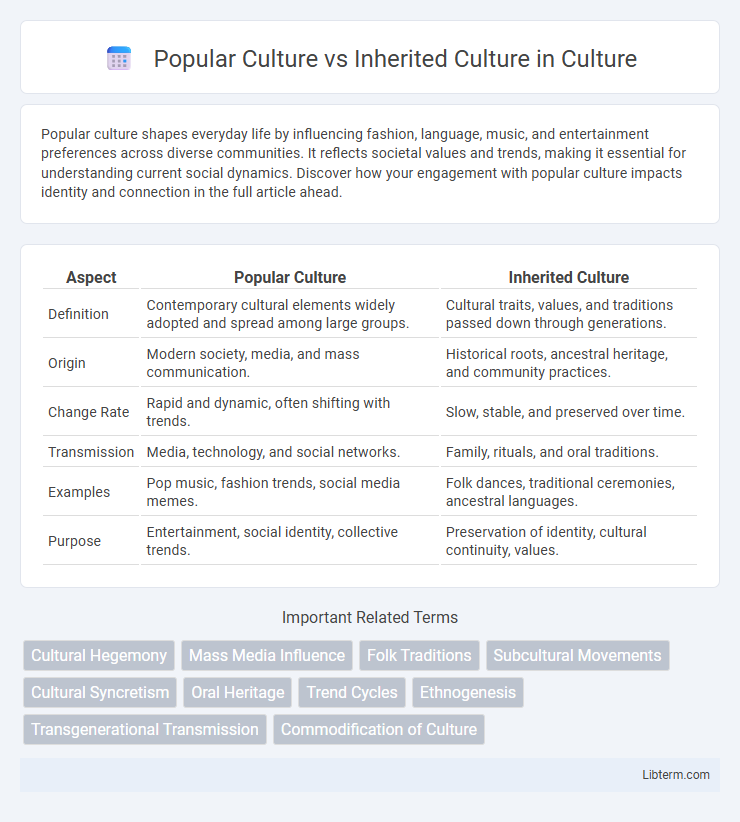Popular culture shapes everyday life by influencing fashion, language, music, and entertainment preferences across diverse communities. It reflects societal values and trends, making it essential for understanding current social dynamics. Discover how your engagement with popular culture impacts identity and connection in the full article ahead.
Table of Comparison
| Aspect | Popular Culture | Inherited Culture |
|---|---|---|
| Definition | Contemporary cultural elements widely adopted and spread among large groups. | Cultural traits, values, and traditions passed down through generations. |
| Origin | Modern society, media, and mass communication. | Historical roots, ancestral heritage, and community practices. |
| Change Rate | Rapid and dynamic, often shifting with trends. | Slow, stable, and preserved over time. |
| Transmission | Media, technology, and social networks. | Family, rituals, and oral traditions. |
| Examples | Pop music, fashion trends, social media memes. | Folk dances, traditional ceremonies, ancestral languages. |
| Purpose | Entertainment, social identity, collective trends. | Preservation of identity, cultural continuity, values. |
Defining Popular Culture and Inherited Culture
Popular culture refers to contemporary practices, beliefs, objects, and phenomena embraced by the general population, often characterized by mass media, entertainment, and trends that change rapidly across societies. Inherited culture consists of traditions, customs, values, language, and artifacts passed down through generations, preserving historical identity and deep-rooted social norms. Understanding these definitions highlights how popular culture evolves dynamically, while inherited culture maintains continuity and cultural heritage.
Origins and Evolution: How Cultures Emerge
Popular culture originates from contemporary, often urban settings and evolves rapidly through mass media, technology, and social interaction, reflecting current trends and collective preferences. In contrast, inherited culture is deeply rooted in historical traditions, passed down through generations, preserving beliefs, customs, and practices that form a community's identity. Both types of culture emerge as responses to human needs for expression, belonging, and communication, shaping and reshaping societal values over time.
Transmission: Media vs Tradition
Popular culture spreads rapidly through mass media platforms such as television, social media, and the internet, allowing trends and ideas to reach global audiences almost instantly. Inherited culture relies on traditional transmission methods like oral storytelling, rituals, and family teachings passed down from generation to generation within specific communities. Media-driven transmission emphasizes innovation and broad accessibility, while tradition-based transmission focuses on preservation and cultural continuity.
Key Characteristics: Fluidity vs Stability
Popular culture exhibits fluidity, constantly evolving through trends, media, and technology that reflect current societal preferences and behaviors. Inherited culture maintains stability by preserving traditions, values, and customs passed down through generations, providing a consistent identity and continuity. The contrast between popular culture's adaptability and inherited culture's permanence highlights the dynamic interplay between innovation and heritage in shaping social experiences.
Influence of Technology on Popular Culture
Technology accelerates the evolution of popular culture by enabling rapid dissemination of trends through digital platforms and social media, reshaping music, fashion, and entertainment industries globally. In contrast, inherited culture remains rooted in traditional practices and values, often preserved through oral history and ritual, less subject to the fast-paced changes driven by technological advancements. The pervasive influence of smartphones, streaming services, and virtual communities continuously transforms popular culture dynamics, creating a fluid cultural landscape distinct from the stability of inherited cultural heritage.
The Role of Family in Preserving Inherited Culture
The role of family in preserving inherited culture is crucial as it serves as the primary conduit for transmitting traditions, language, and values across generations. Families engage in rituals, storytelling, and cultural practices that reinforce collective identity and continuity within a rapidly evolving popular culture landscape. This intergenerational transmission helps maintain cultural heritage amidst external influences and societal change.
Globalization and Cultural Hybridization
Popular culture evolves rapidly through globalization, spreading trends and media across diverse societies, while inherited culture maintains traditional practices and values passed down through generations. Cultural hybridization emerges as global influences blend with inherited customs, creating unique identities that reflect both modernity and tradition. This dynamic exchange fosters innovation in art, language, and social norms, reshaping cultural landscapes worldwide.
Identity Formation: Navigating Two Worlds
Popular culture shapes identity through dynamic media, fashion, and trends, reflecting contemporary societal values and global influences. Inherited culture grounds identity in traditions, customs, and collective history passed down through generations, providing a sense of belonging and continuity. Navigating between popular and inherited cultures involves balancing innovation with preservation, allowing individuals to construct multidimensional identities that resonate across local and global contexts.
Conflicts and Synergies Between the Cultures
Popular culture often challenges inherited culture by introducing new values and practices that may conflict with traditional norms, leading to tensions in societal acceptance. However, synergies emerge when elements of inherited culture are adapted into popular culture, fostering a dynamic fusion that revitalizes cultural heritage. This interplay promotes cultural evolution while preserving foundational identities through selective integration and reinterpretation.
The Future of Cultural Dynamics
Popular culture evolves rapidly through digital media, shaping global identities and consumer behaviors, while inherited culture preserves traditions that maintain historical continuity and community cohesion. Advances in technology and globalization blur boundaries between popular and inherited cultures, creating hybrid cultural expressions that reflect diverse influences. Future cultural dynamics will increasingly depend on adaptive frameworks balancing preservation of heritage with innovation driven by social connectivity and technological progress.
Popular Culture Infographic

 libterm.com
libterm.com